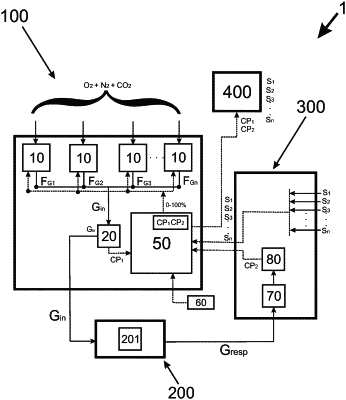| CPC A61M 16/0003 (2014.02) [G16H 40/63 (2018.01); A61M 2016/003 (2013.01); A61M 2205/3331 (2013.01); A61M 2230/04 (2013.01); A61M 2230/432 (2013.01); A61M 2230/435 (2013.01); A61M 2230/50 (2013.01); A61M 2230/63 (2013.01)] | 27 Claims |

|
1. Intelligent control system, based on machine learning, to modulate end-tidal concentration levels through continuous adjustments in the volume and concentration of a flow of incoming respiratory gases, said system comprising:
a plurality of flow controllers, wherein each flow controller in the plurality of flow controllers is configured to generate at least one flow of flow gases, wherein convergence of the flow gases generates a flow of incoming gases;
a first sensor configured to sample and measure, in real time, a first of concentration and pressure signal from the flow of incoming gases administered in a respiratory device at a current breathing moment;
a second sensor configured to sample and measure a second concentration and pressure signal of a respiration gas flow within the respiratory device at the current respiratory moment; and
a control unit associated with the first sensor and the second sensor, in which the control unit is configured to estimate, in real time, and based on the first and second concentration and pressure signals measured in the current moment of respiration and in the concentration and pressure signals measured in prior respiratory moments, a new volume and a new concentration of oxygen and carbonic gas for the flow of incoming gases for an immediate future inspiratory moment, the immediate future inspiratory moment occurring after the current respiratory moment,
wherein the adjustment of the new volume and the new concentration of oxygen and carbon dioxide occurs through the activation and individual control of each of the flow controllers, and
wherein the control unit is further configured to adjust the volume and concentration of oxygen and carbonic gas of the flow of incoming gases several times within the same inspiratory cycle.
|